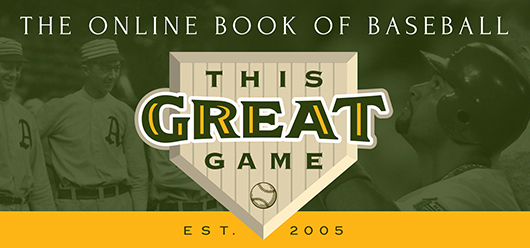THE TEAMS
The Rockies’ Five Greatest Hitters
 Todd Helton (1997-2013)
Todd Helton (1997-2013)
The most tenured of Colorado’s Blake Street Bombers, Helton has earned his status as Mr. Rockie—churning out thunderous numbers through the first half of his career before losing the power in the second half, remaining dangerous with his consistent ability to reach base. He holds virtually ever major hitting record in Rockies history.
Helton grew up a star quarterback and attended the University of Tennessee, but decided to focus on baseball when his role on the football team was reduced with the arrival of another stud quarterback: Peyton Manning. Manning got Indianapolis, Helton got Denver; the left-handed slugger almost immediately made an impact for the Rockies in the late 1990s and only got better, producing prodigious numbers on an annual basis.
From 2000-01, Helton hit a monstrous peak. In 2000, he slammed 42 home runs and led the National League with a .372 average, 216 hits, 59 doubles and 147 runs batted in; his 103 extra-base hits set a league record. He topped that mark by two the next season while belting a career-high 49 homers with 146 RBIs. Though Barry Bonds, on his way to 73 homers, would best Helton that same year with 107 long hits, Helton would stake a claim as the only NL hitter since Chuck Klein, nearly 70 years earlier, to collect at least 400 total bases in consecutive seasons.
Helton averaged 35 homers through his first seven full years; over the next eight, he never hit more than 20 thanks to a bad back (among other maladies) and the introduction of the humidor in the mid-2000s that deadened the balls at Coors Field. Yet as his power waned, Helton remained potent, nearly winning another batting title in 2003—he finished second to Albert Pujols by less than half a point—and became the first major leaguer to knock out at least 35 doubles in 10 straight years. But as a .345 career hitter at Coors (as compared to a still-dignified .287 on the road), the let-up in Helton’s slugging game will likely weaken his Hall-of-Fame chances, already “poisoned” by the reputation for earning cheap stats playing half his games a mile high.
Thriving during the heart of the steroid era, Helton did not escaped accusation; in 2005, Colorado broadcaster Wayne Hagin once insisted that former Rockies manager Don Baylor told him that he tried to get Helton off of steroids, because he was too good for them; an infuriated Helton vehemently denied the charge and threatened legal action. Hagin quickly backpedaled, saying that the drug discussed was actually the legal supplement creatine.
 Larry Walker (1995-2004)
Larry Walker (1995-2004)
No Colorado player tore apart opponents more at Coors Field than Walker, the left-handed slugger who escaped from Montreal after years of tantalizing promise with the talented, low-budget Expos. The trick for Walker was simply to stay 100% healthy.
A career .313 hitter with 383 lifetime dingers over 17 years—the bulk of which were spent with the Rockies—Walker was an absolute offensive menace in Colorado, winning three NL batting titles over four years with .363, .379 and .350 averages in 1998, 1999 and 2001, respectively. Those numbers were nothing, however, compared to what Walker did playing in front of the home fans, where he hit .381 over his career and, in 1999, forged an incredible .461 average with 26 homers and 70 RBIs in just 66 games at Coors Field.
In 1997, Walker took home the NL MVP with a complete seasonal performance, combining great hitting (a .366 average, second to Tony Gwynn), power (a league-leading 49 homers and 130 RBIs), speed (33 steals) and near-flawless glovework in right field (collecting 12 assists). Just to show that it wasn’t all Coors Field, 29 of Walker’s 49 homers that year were hit on the road.
Walker’s biggest foe in baseball was injury. Only once did he log more than 150 games, and only during a handful of others did he even make it to 140; it must shudder one to think how much more sensational his numbers might have been had he not accrued all the nicks and knacks of everyday baseball. Hall-of-Fame voters were satisfied enough with what they saw, making Walker the first Rockie to be enshrined at Cooperstown.
 Nolan Arenado (2013-20)
Nolan Arenado (2013-20)
At first glance, the California native appeared constantly fidgety, and that’s because he was diagnosed at an early age with ADHD (Attention Deficit Hyperactivity Disorder). His medicine: Baseball. It’s a remedy that served him well on the ballfield.
From his 2013 debut, Arenado quickly and arguably established himself as the game’s premier third baseman of his generation; in all eight of his seasons with the Rockies, he nabbed eight Gold Gloves with a remarkable display of defense. But his offensive game was equally impressive; after a relatively couple modest campaigns to start his career, Arenado exploded in 2015 with his first of two seasons collecting at least 40 homers and 130 RBIs, adding a third 130-RBI campaign in 2017; in 2018, he led the NL for a third time in home runs with 38. If that wasn’t enough, Arenado set the Colorado record for the longest hitting streak (28 games, in 2014) and the most consecutive games with a home run (six, in 2015); in June 2017, he became the first major leaguer to complete a cycle by belting a walk-off, come-from-behind home run to win a game.
The Rockies were impressed enough that they handed Arenado a massive eight-year, $260 million contract early in 2019—a deal agreed to, he claims, with the understanding that the Rockies would build a winner around him. But things quickly soured a year later when Arenado and Colorado general manager Jeff Bridich reportedly engaged in a “confrontational” discussion over the Rockies’ decision to stand pat for 2020, leaving the five-time All-Star to state that he felt “disrespected” by the front office. In the immediate aftermath, rumors ran wild of an impending Arenado trade; after a flat, pandemic-shortened 2020 season in which he hit batted .253 while playing with an injured shoulder, the rumors resurfaced again—and this time became reality when Arenado was dealt to the St. Louis Cardinals months before his 30th birthday.
 Matt Holliday (2004-08)
Matt Holliday (2004-08)
As Helton and Walker took their declines into the mid-2000s, Holliday came along to fill in the void. Like Helton, the Oklahoma-born Holliday was a star prep quarterback, but he passed up a chance to play at Oklahoma State to sign with the Rockies. Within a few years of his debut in Colorado, he became the team’s star hitter; in 2007, he was concretely instrumental in lifting the Rockies on their magical late-season run to the World Series, leading the NL with a .340 average, 137 RBIs, 216 hits and 50 doubles to finish a very close second in league MVP voting to Philadelphia’s Jimmy Rollins. Holliday continued to hit well in the postseason, launching five home runs with 10 RBIs in 11 games.
After a slight cool-off in 2008, the Rockies avoided imminent free agency for Holliday by sending him to Oakland in a neat deal that would net them closer Huston Street and future star Carlos Gonzalez. Convinced he was living a temporary existence with the low-rent A’s, Holliday responded poorly; sure enough, barely four months later, he was traded back to the NL and St. Louis, where his game re-awoke—thus showing he was no Coors Field fluke—and was rewarded by the Cardinals with a lucrative long-term contract. In 2018, a 38-year-old Holliday returned to the Rockies on a minor league contract and, in 25 games, hit .283 with a pair of home runs.
 Andres Galarraga (1993-97)
Andres Galarraga (1993-97)
The burly, imposing Venezuelan native nicknamed the Big Cat (with apologies to Johnny Mize) experienced a promising start with the Expos during the late 1980s, but his hitting collapsed and he found himself in Colorado as a throwaway reclamation project for the Rockies for their inaugural 1993 campaign. Yet Rockies manager Don Baylor, who had paired up with Galarraga a year earlier as his batting coach in St. Louis, tinkered with his batting mechanics to the point that Galarraga became an instant born-again hitting star who was better than ever in Denver; he became the first player on a first-year expansion team to win a batting title with a .370 mark—the highest by any right-handed hitter since Joe DiMaggio in 1939.
Although Galarraga would never vie again for another batting crown, a power surge in the mid-1990s made him no less fearsome; he hit over 40 homers in three successive seasons (1996-98)—the last of which came after a trade to the Atlanta Braves, showing that Coors Field wasn’t purely behind the uptick in slugging. With the Rockies, Galarraga specialized in cleaning up the bases; he led the league with 150 RBIs in 1996—the most by a National Leaguer since 1962—and followed that up with another league-leading 140 in 1997.
After his time in Denver, Galarraga bounced around over the final six years of his career, playing for five teams (including two separate stints with San Francisco); he was popular with fans and teammates wherever he showed up, and still packed a punch to the end—even after missing the entire 1999 campaign when he was diagnosed with lymphoma in his back. (It returned again in 2004 and underwent more chemotherapy; he has had no further relapses.)
Colorado Rockies Team History A decade-by-decade history of the Rockies, the ballparks they’ve played in, and the four people who are on the franchise’s Mount Rushmore.
The Rockies’ Five Greatest Pitchers A list of the five greatest pitchers based on their productivity and efficiency.
The Rockies’ Five Most Memorable Games A list of five memorable games and other notable personal achievements that have defined the Rockies’ history.




